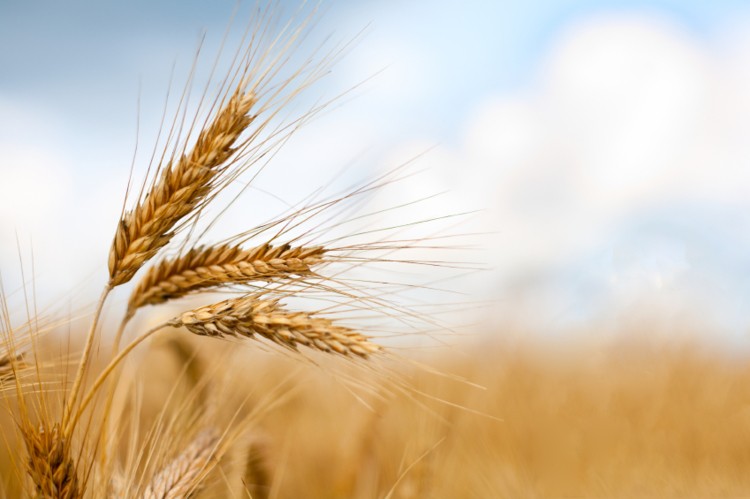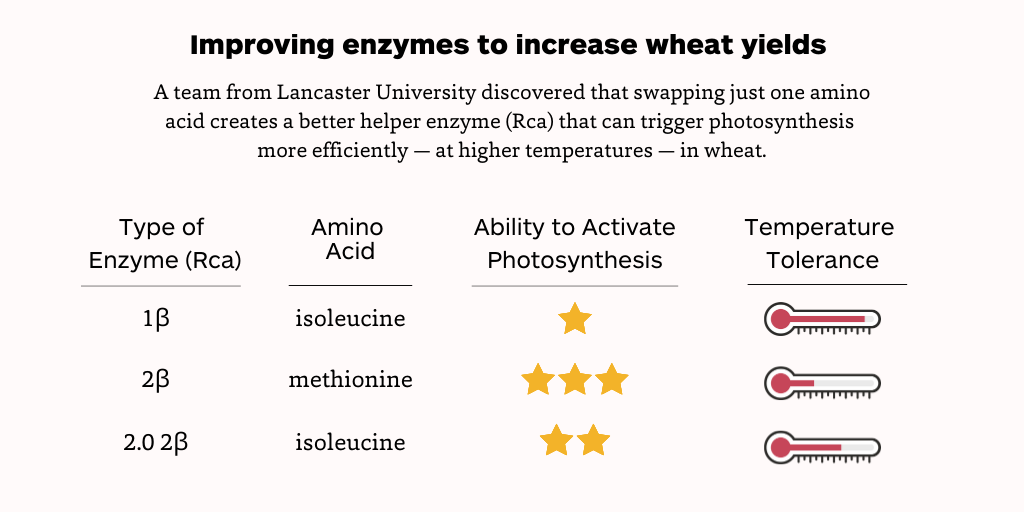Scientists unlocking heat-tolerant wheat

Researchers working on molecular-level responses in crops have taken a step closer to their goal of producing heat-tolerant wheat. “This benefits the sustainability of the food system by protecting food supply as the climate changes,” project lead Dr Elizabete Carmo-Silva says.
In plants, Rubisco activase (Rca) tells the energy-producing enzyme Rubisco to kick in when the sun is shining and stop when the leaf is deprived of light, in order to conserve energy.
A team of researchers from Lancaster University have found that swapping one molecular building block out of the 380 that make up Rca in wheat enables it to activate Rubisco faster in hotter temperatures. This, the researchers believe, suggests an opportunity to help protect crops from rising temperatures.
“We took a wheat Rca (2β) that was already pretty good at activating Rubisco in lower temperatures and swapped out just one of its amino acids with one found in another wheat Rca (1β) that works pretty well in higher temperatures but is rubbish at activating Rubisco — and the result is a new form of 2β Rca that is the best of both worlds,” explained Elizabete Carmo-Silva, a senior lecturer at the Lancaster Environment Centre who oversaw the work.
Naturally occurring wheat Rca 1β has an isoleucine amino acid, works up to 39 degrees Celcius, but isn’t great at activating Rubisco. Whereas the naturally occurring 2β has a methionine amino acid, works up to about 30 degrees Celcius, and is good at activating Rubisco. The team has created a new version of 2β with an isoleucine amino acid that works up to 35 degrees Celcius and is quite good at activating Rubisco.
"Essentially, 1β is a rubbish enzyme and 2β is sensitive to higher temperatures,” Dr Carmo-Silva said. “The cool thing here is that we have shown how this one amino acid swap can make Rca active at higher temperatures without really affecting its efficiency to activate Rubisco, which could help crops kickstart photosynthesis under temperature stress to churn out higher yields.”

Building a more sustainable food system
Carmo-Silva said that the work could contribute to the development of a more sustainable food system on two fronts.
Firstly, it will facilitate the development of wheat varieties that are more resilient in the face of climate change.
“Global warming is already having an impact in the productivity of many crops, including wheat. Improving the efficiency with which Rubisco activase turns on the energy-producing enzyme (Rubisco) when the sun is shining, would make these crops more resilient to the fluctuations we are observing in seasonal temperatures, thereby ensuring that crop yields are more stable. This would be huge for farmers, to be able to trust they will get a good yield out of each year’s crop. In turn, it benefits the sustainability of the food system by protecting food supply as the climate changes,” she told FoodNavigator.
Secondly, Carmo-Silva suggested the discovery would allow us to produce more food using fewer land resources – and increasing carbon assimilation levels - in order to meet the needs of the growing global population.
“Current evidence, from experimental work combined with modelling, suggests that making Rubisco activase more efficient at turning on carbon assimilation by Rubisco when the sun is shining would result in an increase in daily carbon assimilation by around 20%, even in the absence of plant stress. Under abiotic stress, such as temperature fluctuations, carbon assimilation and plant productivity are negatively affected, meaning that the benefits of having more efficient and climate resilient carbon assimilation would be even greater. What’s most important is that we predict these gains in carbon assimilation and plant productivity should not require any additional land, water or fertilisers, therefore making agriculture more sustainable and resilient to climate change. This means having more food to support the growing population while minimising our impact on the planet.”
Does this mean the wheat would be GMO?
This work was carried out in vitro in E. coli. This means all the work was done ‘in a test tube’.
“We first need to understand how the enzyme Rubisco activase responds to temperatures, and how can we make it more efficient at activating carbon assimilation as the temperature increases. To do this, we used site-directed mutagenesis to change 1 single amino acid in Rubisco activase, which is 380 amino acids long,” Dr Carmo-Silva elaborated.
The next phase will require the change to be introduced to wheat plants. “We can do using either GMO or CRISPR [gene editing] techniques,” Dr Carmo-Silva explained.
However, she continued, the scientists are exploring both GMO and non-GMO options.
“We are exploring the possibility that a form of Rubisco activase with this amino acid change might already exist in nature. To do this we are looking at plants that are related to wheat, including ancestral wheats. If we were to find such a Rubisco activase that had this amino acid change and was more efficient at warmer temperatures, this could be taken forward in crop breeding programmes in a more traditional way (non-GMO), by making crosses between the modern and ancestral wheats.”
Extending to other crops
There is also the potential for this finding to make other crop varieties more resilient and efficient.
The research is part of a project called Realizing Increased Photosynthetic Efficiency (RIPE). RIPE is engineering crops to be more productive by improving photosynthesis, the natural process all plants use to convert sunlight into energy and yields. The work is supported by the Bill & Melinda Gates Foundation, the US Foundation for Food and Agriculture Research (FFAR), and the UK Government’s Department for International Development (DFID).
This study’s findings will support RIPE’s efforts to characterise and improve the Rca of other food crops such as cowpea and soybean, each with multiple different forms of Rca.
“The work we have just published focused on the Rubisco activase from wheat and we have accumulated a really good understanding of how the enzyme in this plant operates. We are now working on other crop plants including cowpea, or black-eyed bean, an important crop for sub-Saharan Africa, as well as soybean.
“The findings in wheat are informing our work with these other crops and initial results suggest there is a similar scope for improvement of the yields of these crops by making Rubisco activase more efficient at turning on carbon assimilation when the sun shines.”
“When looking at cowpea growing regions in Africa, it goes all the way from South Africa with an average around 22 degrees Celcius to Nigeria at about 30, and areas further north get to 38,” Carmo-Silva said. “If we can help Rubisco activate more efficiently across these temperatures, that is really powerful and could help us close the gap between yield potential and the reality for farmers who depend on these crops for their sustenance and livelihoods.”
Source
'An isoleucine residue acts as a thermal and regulatory switch in wheat Rubisco activase'
The Plant Journal
DOI: https://doi.org/10.1111/tpj.14766
Authors: Gustaf E. Degen, Dawn Worrall, Elizabete Carmo‐Silva
By: Katy Askew || FoodNavigator
RELATED RIPE OBJECTIVES
Improving Rubiscos